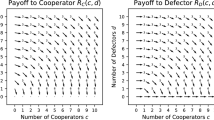Abstract
We consider a mathematical model for the group size determination by the intra-reactions, self-growth, ostracism and fission within a group, and by the inter-reactions, immigration and fusion between two groups. In some group reactions, a conflict between two groups occurs about the reaction to change the group size. We construct a mathematical model to consider such conflict, taking into account the inclusive fitness of members in each group. In the conflict about the fusion between two groups, our analysis shows that the smaller group wants to fuse, while the larger does not. Also the criterion to resolve the conflict is discussed, and some numerical examples are given, too. It is concluded that, depending on the deviation in the total cost paid for the conflict by counterparts, the group reactions could result in a terminal group size different from that reached only by a sequence of outsider's immigrations into a group.
Similar content being viewed by others
References
Alden Smith, E.: The application of optimal foraging theory to the analysis of hunter-gatherer group size. In: Winterhalder B, Alden Smith E, (eds.) Hunter-gatherer Foraging Strategies. pp 36–65 Chicago University Press, Chicago, 1981
Alden Smith, E.: Inuit foraging groups: some simple models incorporating conflicts of interest, relatedness, and central-place sharing. Ethol. Sociobiol. 6, 27–47 (1985)
Axelrod, R.: The Evolution of Cooperation. Basic Books, New York, 1984
Axelrod, R., Hamilton, W.D.: The evolution of cooperation. Science 211, 1390–1396 (1981)
Beecham, J.A., Farnsworth, K.D.: Animal group forces resulting from predator avoidance and competiton minimization. J. theor. Biol. 198, 533–548 (1999)
Caraco, T., Wolf, L.L.: Ecological determinants of group sizes of foraging lioss. Am. Nat. 109, 343–352 (1975)
Clark, C.W., Mangel, M.: Foraging and flocking strategies: information in an uncertain environment. Am. Nat. 123, 626–641 (1984)
Flierl, G., Grünbaum, D., Levin, S., Olson, D.: From individuals to aggregations: the interplay between behavior and physics. J. theor. Biol. 196, 397–454 (1999)
Giraldeau, L.A.: The stable group and the determinants of group sizes in foraging group size. In: Slobodchikoff CN, (ed.) The ecology of social behavior. pp 33–53. Academic Press, New York, 1988
Giraldeau, L.A., Caraco, T.: Genetic relatedness and group size in an aggregation economy. Evol. Ecol. 7, 429–438 (1993)
Giraldeau, L.A., Caraco, T.: Social foraging theory. Princeton University Press, Princeton, 2000
Gueron, S.: The steady-state distributions of coagulation-fragmentation processes. J. Math. Biol. 37, 1–27 (1998)
Gueron, S., Levin, S.A.: The dynamics of group formation. Math. Biosci. 128, 243–264 (1995)
Gueron, S., Levin, S.A., Rubenstein, D.I.: The dynamics of herds: From individuals to aggregations. J. theor. Biol. 182, 85–98 (1996)
Hamilton, W.D.: The evolution of social behavior. J. theor. Biol. 7, 1–52 (1964)
Higashi, M., Yamamura, N.: What determines animal group size: insider-outsider conflict and its resolution. Am. Nat. 142, 553–563 (1993)
Houston, A., Clark, C., McNamara, J., Mangel, M.: Dynamic models in behavioural and evolutionary ecology. Nature 332, 29–34 (1988)
Humphries, S., Ruxton, G.D., Metcalfe, N.B.: Group size and relative competitive ability: geometric progressions as a conceptual tool. Behav. Ecol. Sociobiol. 47, 113–118 (2000)
Krebs, J.R., Davies, N.B.: An introduction to behavioral ecology, 2nd edn. Blackwell Scientific Publications, Oxford, 1981
Levin, S.A.: Grouping in population models. In: Mollison D et al., (ed.) Epidemic models: their structure and relation to data, pp. 271–278. Cambridge University Press, Cambridge, 1995
Mangel, M., Clark, C.W.: Dynamic modeling in behavioural ecology. Princeton University Press, Princeton, 1988
Martinez, F.A., Marschall, E.A.: A dynamic model of group-size choice in the coral reef fish Dascyllus albisella. Behav. Ecol. 10, 572–577 (1999)
Maynard Smith, J.: The theory of games and the evolution of animal conflicts. J. theor. Biol. 47, 209–221 (1974)
Maynard Smith, J.: The problems of biology. Oxford University Press, Oxford, 1986
Packer, C., Scheel, D., Pusey, A.E.: Why lions form groups: food is not enough. Am. Nat. 136, 1–19 (1990)
Parrish, J.K., Hamner, W.M. (eds.): Animal groups in three dimensions. Cambridge University Press, Cambridge, 1997
Rodman, P.S.: Inclusive fitness and group size with a reconsideration of group sizes in lions and wolves. Am. Nat. 118, 275–283 (1981)
Seger, J.: Opportunities and pitfalls in co-operative reproduction. In: Keller L, (ed.) Queen numbers and sociality in insects, pp 1–15. Oxford Scientific Publisher, Oxford, 1993
Sibly, R.M.: Optimal group size is unstable. Anim. Behav. 31, 947–948 (1983)
Wilson, E.O.: Sociobiology. Harvard University Press, Cambridge, 1975
Yamamura, N., Higashi, M.: An evolutionary theory of conflict resolution between relatives: altruism, manipulation, compromise. Evolution 46, 1236–1239 (1992)
Author information
Authors and Affiliations
Corresponding author
Rights and permissions
About this article
Cite this article
Seno, H. Group size determined by fusion and fission A mathematical modelling with inclusive fitness. J. Math. Biol. 52, 70–92 (2006). https://doi.org/10.1007/s00285-005-0341-7
Received:
Revised:
Published:
Issue Date:
DOI: https://doi.org/10.1007/s00285-005-0341-7




